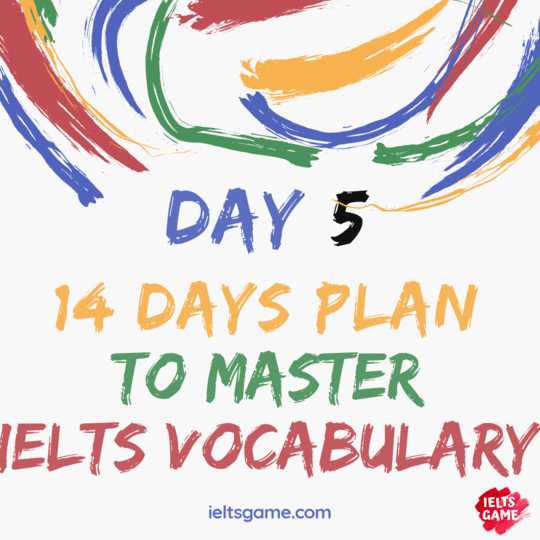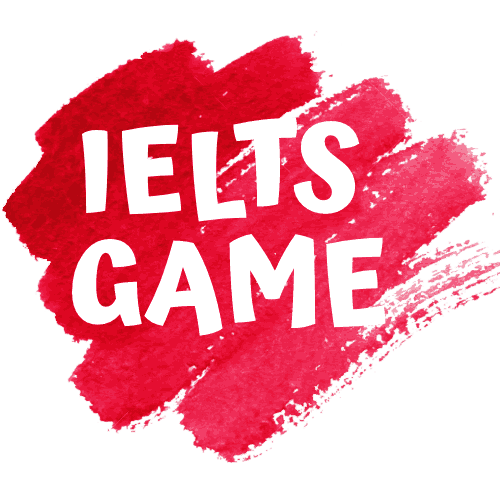14 days plan to master IELTS Vocabulary | Day 5

At the second day of 14 days plan to master IELTS vocabulary in IELTS Game, we will help you to study academic IELTS vocabulary along with grammar to pass the IELTS and get a high score in the exam.
In this 14-day course for preparation for IELTS exam, you will study a wide range of IELTS vocabulary and words through two ways:
As mentioned before, you will study 3 videos from IELTS vocabulary course plus you will read a reading passage from the previous actual IELTS exams.
Vocabulary for IELTS – Day 5
In these 3 videos, you will learn synonyms for English vocabulary related to three topics:
- Illness
- Law 1
- Law 2
Then, you will find the reading passage number 1 from Cambridge IELTS 12 – test 2.
You should read it and try to understand the overall meaning, write the new words and try to use it in English examples.
You can open Oxford dictionary to know the meaning of the English words you don’t know.
IELTS Vocabulary Videos
In this lecture, you will learn seven IELTS vocabulary connected with Illness:
- Acute
- Chronic
- Addict
- Allergy
- Syndrome
- Epidemic
- Trauma
In this lecture, you will learn seven IELTS words connected with Law 1:
- Advocate
- Abide by
- Enforce
- Invoke
- Jurisdiction
- Litigate
- Prosecute
In this lecture, you will learn seven IELTS vocabulary connected with Law 2:
- Clause
- Comply
- Exempt
- Ratify
- Sanction
- Uphold
- Violate
Read also:
30 Essential IELTS grammar rules and usage
December 29, 2022Advanced words for IELTS writing with meaning
December 27, 2022It is important for people to take risks IELTS writing task 2
December 26, 2022IELTS 12 – Test 2 – Reading Passage 2
Now, read this passage which is came from previous IELTS exams, and don’t try to answer the questions.
Just read it to improve your English language and gain new vocabularies and idioms.
The Lost City
An explorer’s encounter with the ruined city of Machu Picchu, the most famous icon of the Inca civilsation
Paragraph A
When the US explorer and academic Hiram Bingham arrived in South America in 1911, he was ready for what was to be the greatest achievement of his life: the exploration of the remote hinterland to the west of Cusco, the old capital of the Inca empire in the Andes mountains of Peru.
His goal was to locate the remains of a city called Vitcos, the last capital of the Inca civilisation.
Cusco lies on a high plateau at an elevation of more than 3,000 metres, and Bingham’s plan was to descend from this plateau along the valley of the Urubamba river, which takes a circuitous route down to the Amazon and passes through an area of dramatic canyons and mountain ranges.
Paragraph B
When Bingham and his team set off down the Urubamba in late July, they had an advantage over travelers who had preceded them: a track had recently been blasted down the valley canyon to enable rubber to be brought up by mules from the jungle.
Almost all previous travelers had left the river at Ollantaytambo and taken a high pass across the mountains to rejoin the river lower down, thereby cutting a substantial corner, but also therefore never passing through the area around Machu Picchu.
Paragraph C
On 24 July they were a few days into their descent of the valley. The day began slowly, with Bingham trying to arrange sufficient mules for the next stage of the trek.
His companions showed no interest in accompanying him up the nearby hill to see some ruins that a local farmer, Melchor Arteaga, had told them about the night before. The morning was dull and damp, and Bingham also seems to have been less than keen on the prospect of climbing the hill.
In his book Lost City of the Incas, he relates that he made the ascent without having the least expectation that he would find anything at the top.
Paragraph D
Bingham writes about the approach in vivid style in his book. First, as he climbs up the hill, he describes the ever-present possibility of deadly snakes, ‘capable of making considerable springs when in pursuit of their prey’; not that he sees any.
Then there’s a sense of mounting discovery as he comes across great sweeps of terraces, then a mausoleum, followed by monumental staircases and, finally, the grand ceremonial buildings of Machu Picchu. ‘It seemed like an unbelievable dream … the sight held me spellbound …’ he wrote.
Paragraph E
We should remember, however, that Lost City of the Incas is a work of hindsight, not written until 1948, many years after his journey. His journal entries of the time reveal a much more gradual appreciation of his achievement.
He spent the afternoon at the ruins noting down the dimensions of some of the buildings, then descended and rejoined his companions, to whom he seems to have said little about his discovery.
At this stage, Bingham didn’t realise the extent or the importance of the site, nor did he realise what use he could make of the discovery.
Paragraph F
However, soon after returning it occurred to him that he could make a name for himself from this discovery. When he came to write the National Geographic magazine article that broke the story to the world in April 1913, he knew he had to produce a big idea.
He wondered whether it could have been the birthplace of the very first Inca, Manco the Great, and whether it could also have been what chroniclers described as ‘the last city of the Incas’. This term refers to Vilcabamba, the settlement where the Incas had fled from Spanish invaders in the 1530s.
Bingham made desperate attempts to prove this belief for nearly 40 years. Sadly, his vision of the site as both the beginning and end of the Inca civilisation, while a magnificent one, is inaccurate. We now know that Vilcabamba actually lies 65 kilometres away in the depths of the jungle.
Paragraph G
One question that has perplexed visitors, historians and archaeologists alike ever since Bingham, is why the site seems to have been abandoned before the Spanish Conquest. There are no references to it by any of the Spanish chroniclers – and if they had known of its existence so close to Cusco they would certainly have come in search of gold.
An idea which has gained wide acceptance over the past few years is that Machu Picchu was a moya, a country estate built by an Inca emperor to escape the cold winters of Cusco, where the elite could enjoy monumental architecture and spectacular views.
Furthermore, the particular architecture of Machu Picchu suggests that it was constructed at the time of the greatest of all the Incas, the emperor Pachacuti (c. 1438-71).
By custom, Pachacuti’s descendants built other similar estates for their own use, and so Machu Picchu would have been abandoned after his death, some 50 years before the Spanish Conquest.
Share this Post
